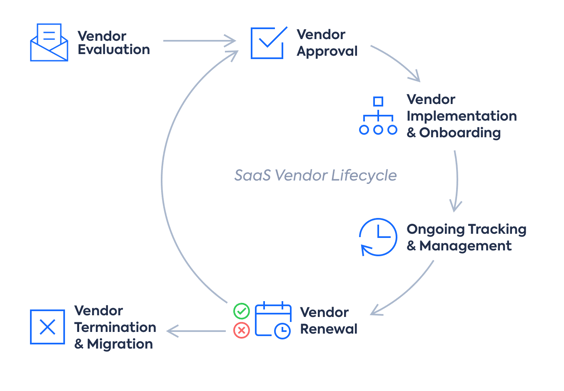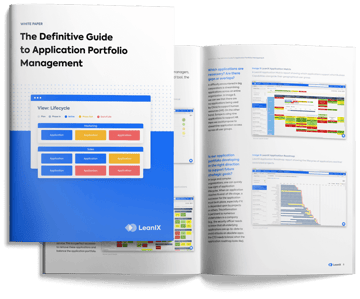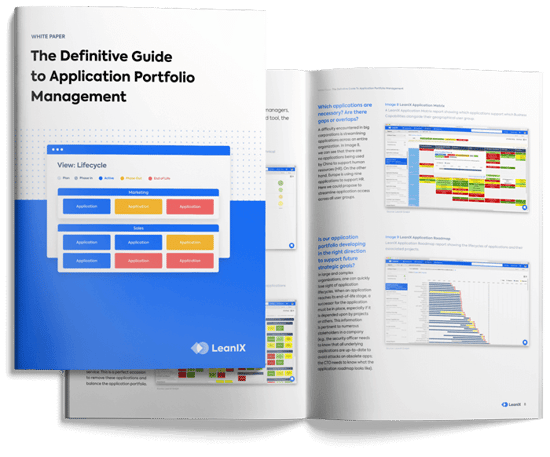Introduction
The world of cloud-based software applications is expanding, each with different costs, contracts, and values. With more competing SaaS providers on the market, SaaS vendor management has become a vital part of SaaS operations, under the broader IT asset management discipline.
With the right strategy in place, you can actively help IT procurement, optimize SaaS applications spend, and find the best solutions to fix business problems. Learn about the benefits of SaaS vendor management and best practices.
What is SaaS vendor management?
SaaS vendor management is a process or strategy to manage a business's SaaS vendor and supplier relationships. Its goal is to find the best IT solution for every business need, manage those solutions, track their usage, report on value, and ultimately, optimize spend.
Vendors are evaluated and managed from approval to onboarding, renewal, or termination— SaaS vendor management means that you manage and have complete control over the entire vendor lifecycle.
 The most important stages of the SaaS vendor lifecycle are outlined below.
The most important stages of the SaaS vendor lifecycle are outlined below.
SaaS vendor evaluation
In order to evaluate a SaaS vendor, there has to be a new vendor request or business need first. Once you’ve identified and defined a specific need, you should start checking your existing SaaS portfolio to see if your company is already paying for a tool that could satisfy this need.
If not, you can start looking into new solutions by comparing your findings on Google or SaaS marketplaces like Gartner, G2, Capterra, and similar.
SaaS vendor procurement and approval
Once you’ve compared all of your options and settled on the best vendor for your needs, you can start with the SaaS procurement and approval process. In this stage, it’s important to consult other departments including procurement, information security, and your IT teams which can perform a detailed assessment of a vendor.
Together, you can review the terms and conditions, ask the right questions for selected services as well as their renewal date before a binding contract is signed.
SaaS implementation and vendor onboarding
In the SaaS onboarding or SaaS implementation stage, you as the client have to make sure that the vendor is brought up to speed about your company’s processes, expectations, goals, and timelines. And likewise, you need to learn about all the vendor processes and see how IT can integrate the new app with existing tools.
Onboarding also involves establishing an application owner, tracking the initial vendor adoption, and communicating any important changes to end-users.
Ongoing management and tracking
Typically, this is the longest stage and will vary from company to company. It involves everything from storing vendor details to tracking SaaS usage, security policies, managing contracts & agreements, and optimizing communication flows with the SaaS vendor.
Proper SaaS management and a good relationship with your supplier will save you from major headaches and prepare your company for the next stage — renewal or termination.
SaaS vendor renewal
As part of your software renewal strategy and before your SaaS contract terms out, you need to decide whether you want to renew the contract or migrate to a different vendor (refer to the first stage). SaaS spend optimization can facilitate this decision process as it will help you assess your SaaS landscape as a whole and discover unused or overlapping apps.
If you opt for a SaaS renewal, you get to re-negotiate your contract, rightsize the number of licenses and also ask your vendor for loyalty discounts.
5 reasons you need SaaS vendor management
According to recent studies, 73% of organizations will have migrated to cloud SaaS for their daily operations by the end of 2021. This number alone builds a strong case for the need for SaaS vendor management within your company.
If done right, it can help you tackle the challenges that come with cloud-first environments and manage the growing number of SaaS subscriptions and providers.
Below are 5 reasons why your enterprise is much better off with SaaS vendor management.
1. Lack of visibility into SaaS purchases
With increased digital literacy, even non-IT employees feel comfortable procuring SaaS solutions that suit their needs. This leads to shadow IT and bloated SaaS portfolios that contain overlapping applications and vendors.
SaaS vendor management creates SaaS visibility and encourages SaaS discovery within the enterprise, especially during the vendor evaluation process. This increased visibility leads to better decisions when it comes to IT solutions which in return will drive growth and lower costs.
2. Unmanaged security risks
With an increase in shadow IT, you’ll also experience an increase in unmanaged SaaS security risks. While your employees’ intentions are good, they might not be able to assess the dangers that come with sharing a company or personal information online. Hacking and phishing attempts pose a real threat to an enterprise’s overall health and reputation.
However, with a strong vendor management process in place, you can find out who makes the majority of SaaS purchases, train employees on risk mitigation practices, and thus increase SaaS security.
3. Wasted SaaS spend
Most enterprises who rely on various SaaS applications across business units and departments also know the pain of SaaS overspending. This ties into the last stage of the SaaS vendor management lifecycle that addresses SaaS renewal and SaaS spend optimization.
By analyzing their annual SaaS spend and vendors with an appropriate management tool, companies can save a significant amount of money and thus maximize the value they get out of using cloud-based applications.
4. Unreviewed SaaS vendor renewals
Many SaaS providers will not notify you early enough to catch the negotiation window before renewal and will increase their price automatically with each upcoming renewal. This is because autorenewals are an easy way to keep customers on board. As part of their SaaS spend optimization efforts, SaaS vendor managers keep track of any upcoming SaaS renewal and are able to predict future spending.
Knowing when to expect a subscription renewal doesn’t take too much effort – the right SaaS management tools come with features like renewal calendars that send out reminders for review. Besides the renewal calendar, promoting purchase accountability within employees proves to be one of the best practices around SaaS renewals.
5. Decreased operational efficiency
Even though SaaS applications come with many great advantages, you also have to be aware of their downsides. As your organization accumulates SaaS subscriptions, your IT infrastructure becomes more complex which increases the burden on IT departments.
SaaS vendor management aims to release this burden by uncovering time and cost-saving opportunities through the rationalization or consolidation of apps. That way, the operational efficiency of IT teams is drastically improved as they deal with fewer support tickets from employees who are struggling with different kinds of SaaS applications.


 The most important stages of the SaaS vendor lifecycle are outlined below.
The most important stages of the SaaS vendor lifecycle are outlined below.


